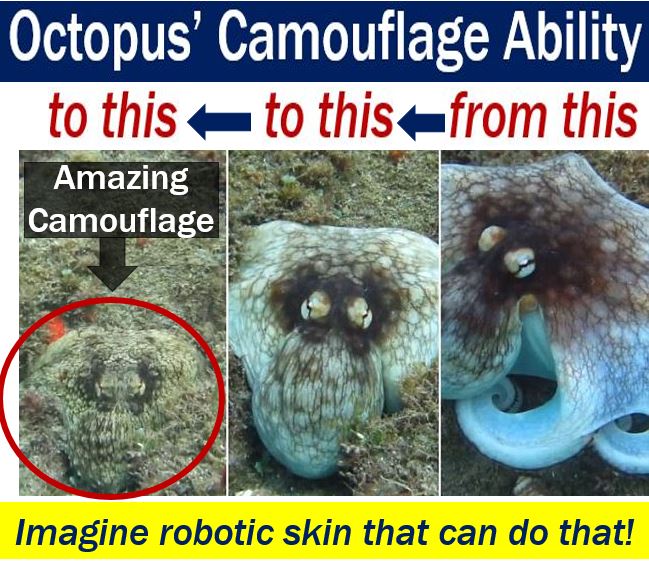Scientists have created a robotic skin that can change color and shape like an octopus. Cornell University researchers created a skin made of layers of rubber, silicone, and mesh. This robotic skin can assume the shape and color of its surroundings. In other words, it can camouflage itself.
Cephalopods can rapidly change their color and shape. Cephalopods are marine invertebrates such as cuttlefish, squid, and octopus.
Group leader Rob Shepherd and colleagues used cephalopods as inspiration to morph flat surfaces into 3-dimensional ones. Their robotic skin can even change shape and color on demand.
Shepherd is an assistant professor at Cornell’s Sibley School of Mechanical and Aerospace Engineering. He teamed up with Itai Cohen and James Pikul to find a way to transform 2-D objects into 3-D shapes.
The scientists used a rigid mesh which they had laser cut in a special way. When they attached the mesh to a stretchable material, it would constrain it to form specific shapes when inflated.
The journal Science has published their study – ‘Stretchable Surfaces with Programmable Texture Morphing for Synthetic Camouflaging Skins.’
What is a robot?
Making robotic skin by observing cephalopods
Shepherd recently installed a 300-gallon fish tank in his lab. He plans to put an octopus in the new aquarium to study it.
Specifically, he wants to study the animal’s texture-morphing abilities. In other words, how its texture changes whenever it wants.
Shepherd plans to apply the octopus’ camouflaging abilities to other research areas. Namely, to make robotic skin.

Regarding texture change in robots, Shepherd said:
“There are many complicated ways to create a texture change in a robot, but we wanted a very simple way to do it.”
The team aimed to precisely inflate something like a balloon into any shape they wanted.
Pikul said:
“If you wanted to take a round balloon and shape it so it looked like a box, it would be pretty difficult. Unless you just put it in a box.”
“That’s the materials and engineering challenge: How can you take these soft materials and control the shape of them?”
Shepherd, Pikul, and Cohen are doing it with a combination of mathematics and bio-inspiration. They dubbed their method CCOARSE. CCOARSE stands for Circumferentially Constrained and Radially Stretched Elastomer.
They have submitted a patent application for what Shepherd described as a “very simple concept.”
Mimicking cephalopod’s camouflaging ability
A cephalopod can change its shape to blend into its surroundings. It does this through the activation of papillae. Papillae are protuberances that extend from the body. They stick out when erector muscles inside the animal contract.
The scientists’ work mimics that by combining a fiber mesh, which they embedded in a silicone elastomer.
The team first poured silicone into a 3-D printed mold of a shape and thickness they wanted. They then placed inextensible mesh, patterned with a laser cutter, onto the uncured silicone.
The scientists set the pattern using a simple algorithm that ultimately determined the final three-dimensional shape.
They then cured the silicone mesh at room temperature. Finally, they poured a coating of silicone on top.
According to a Cornell press release:
“The combination of extensible silicone with inextensible mesh forces the silicone to inflate in the direction and shape desired.”
Cohen explained:
“To design a particular shape, you figure out what its slope is at every point; then you design the amount of strain by including more or less mesh in the region.”
Accurate CCOARSE approximations
The scientists found that their CCOARSE approximations were extraordinarily accurate. In fact, the inflated shapes came within ten percent of the algorithm projections.
The Army Research Office funded the study. It wants the robotic skin for camouflage purposes. Shepherd said there are other potential applications.
Shepherd added:
“You could imagine shipping sheets of material that you would inflate later to be objects. One idea we’ve had is to take a sheet of rubber, send it along with a two-part polyurethane foam that becomes stiff, and people can inflate the rubber with the foam so that it becomes a stiff structure – like furniture.”
Cohen sees other potential applications in robotics. He talked about inflating an arm to carry out certain tasks.
The scientists said they will focus on the skin’s ability to change color as well as texture. They also want to create more precise shapes, and with higher-resolution laser patterning.
